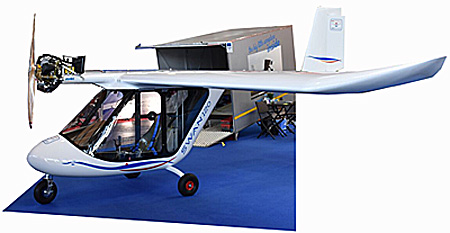
The trailer text reads “the big little airplane inside.” Our video shows how this works.
For three years at Aero Friedrichshafen, the wonderful April show in the south of Germany, I have admired one genuine ultralight called Swan.
Yes, “ultralight!” Swan may not look like a U.S. “ultralight vehicle” as Part 103 rule writers deliberately named the type. Yet I use the term with care. So does the Swan producer.
The company is well aware of three national standards with which Swan neatly complies, they said: England’s SSDR or Single Seat DeRegulated, or Germany’s 120-kilogram class or FAA’s Part 103. These are all surprisingly similar (see this article for more). Swan may need to be equipped carefully to achieve this but the producer assured me it was possible.
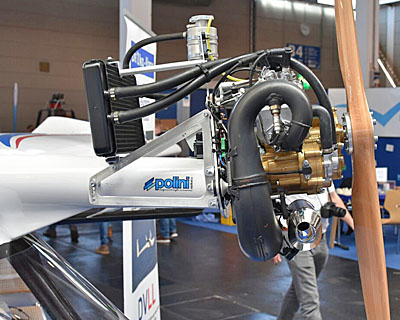
The showplace Swan used a Polini 36-horsepower single cylinder engine.
Naturally, I get that not everyone is into ultralights and/or single seat aircraft. However, interest appears stronger than in many years. No doubt many potential buyers look closely at purchase prices they can afford while for those lucky enough to afford two airplanes, Swan could be their “sport” airplane as some spam can works to haul the family around.
Swan is the “affordable, foldable airplane,” said company owner, aeronautical engineer, and developer Radu Berceanu of Romania. His company is called Avi and they specialize in composite structures ranging from swimming pools to components for street trams and railroad trains. This diversity helps a small airplane producer build such a sleek looking product
Radu’s website only reveals their industrial products today but will be updated for their aircraft, he said at Aero 2018. Until then, the company recommends the website of their German outlet, Modern Wings.
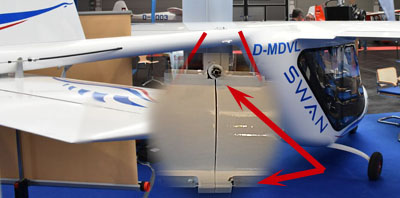
Swan’s unique tail folding mechanism.
In 2017, Avi exhibited an electric engine version with a maximum take off weight of 300 kilograms or 660 pounds. In addition to a two seater seen nearby, the Romanian company plans a float version with a slightly higher gross of 315 kilograms or just under 700 pounds.
“Every version has, after the name Swan, the empty aircraft weight in kilograms and, after the dash, the engine power in horsepower,” said the engineering-oriented company that uses the latest Catia design software for these projects. “For example, Swan 130-30 means a 130 kilogram (286 pound) empty weight version of the aircraft with an engine of 30 horsepower.”
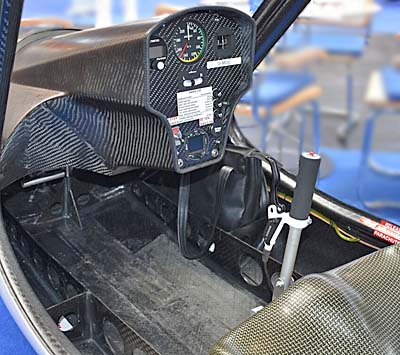
The inside is spacious enough for quite tall or large pilots and the roomy cockpit has a large area for luggage that can be accessed during the flight.
The conventional configuration — tractor engine, tricycle gear, high wings — were chosen to make for easy transition for pilots. “The front wheel is mechanically braked by a handle on the joystick,” said Radu. “Optionally, Swan can have a single hydraulic brake or the main gear wheels can be differentially braked using the pedals.”
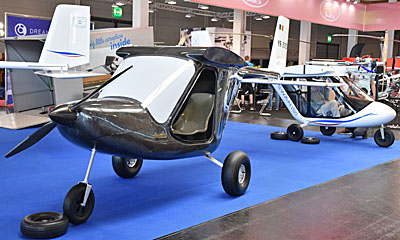
A two seater in progress was displayed at Aero 2018.
“A special design was chosen so that the aircraft can be easily disassembled and stored in a closed trailer, which we offer as well,” Radu said. The trailer can carry 750 kilograms (1,650 pounds) and measures a lean 6 feet by 6.25 feet by 18 feet. Even on Europe’s narrow roads, this would be quite maneuverable and many American yards or driveways could easily accommodate such a small trailer.
The process of assembling and disassembling Swan for the trailer “takes no longer than 20 minutes because only seven screws need to be removed without affecting the flight controls.”
Only a handful of Swans are flying today; Radu said 11 so far. No price is set for U.S. consumption …yet, but this may change after the aircraft becomes better known. To learn more, make direct contact by email.
I predict you will hear more about this aircraft but to hear about it from its creator, watch this interview with Radu at Aero Friedrichshafen 2018…


Look for a larger version of this plane next summer. I have talked to the owner and will try to become the US representative for this plane. Soon as I hear more from the owner of the company, I’ll post it here.
Any current delivery info on the Swan 240 into the US?
Use the links in the article to reach out to the US representative, but I will tell you that at Aero in April, Swan showed their new LE, a single place, and their new low-wing Dracula, also a single place. They had information about the 240 but no physical example.
I’m interested in the AVI. Swan model 240 …. Any other 2 sweaters you may recommend…
Please reach out to the US representative for updates on the two seater.
Empty weight, with Emergency Airframe Parachute — 254 pounds with a Polini 200.
(64mm x 60mm) 193cc. 29hp@8000rpm.
Doesn’t show a good Complete Install Weight for the 200 Engine, probably 45-55 lbs.
What does their Emergency Airframe Parachute Weight?
Without it, might make more Engine Options available.
What does Emergency Airframe Parachute Cost?
———————————
Polini Thor 202 is 33hp@8500rpm
(66mm x 60mm) 205cc.
Once again, doesn’t show a good Complete Install Weight, probably 45-55 lbs.
——————————–
Doesn’t make USA Part 103 without using the BRS Exemption.
Says 260 pounds with Polini 250 36hp@8000rpm. Which has a confirmed 55 lb Install Weight!
——————————-
Polini Thor 303.
38hp@8000rpm
(76mm x 62mm) 281cc.
Once again, doesn’t show a good Complete Install Weight, probably 55-60 lbs.
=====================
MTOW: 550 pounds.
550 lbs = 249.4758 kg / 10 kg = 24.94758 kw needed to Fly Well = 33.45526 hp!
There is a Custom Titanium Tuned Pipe for the Polini 190/200 & 250 that is 3.3 lbs. I don’t know what the Stock Exhaust Weighs. Rotax’s Exhaust is 10-12 lbs.
You sound knowledgeable about the engine but I will comment that eliminating the parachute weight will not buy anything because on a Part 103 ultralight the parachute weight is not a factor.
Nice microlight aircraft. Lots of possibilities here in India for such aircraft if regulation allow us to fly such microlight aircraft using small strips. Nice engine configuration.
Hi Dan,
I enjoy your commentary and reviews, keep up the good work.
I’m interested in talking to the Swan Ultralight guy about his two-seat model. Just looking at the beast I think it would be a great airframe for a pair of motors, direct drive, wing mounted (maybe small air cooled radials). Certainly like the idea of weight concentrated about the CG. I’d like to talk to the guy from Romania about it. Could you either forward this to him or supply an email for a direct contact.
Hi Dave: Thanks for your kind words. You must have missed it as the email was in the article you read. Contact Radu Berceanu via email. Good luck and blue skies!
Since it is an ultralight, do you have to have a licence to fly it in the USA?
Neon: When an aircraft can qualify under FAR Part 103, no pilot certificate is required in the USA, nor is registration or N-numbers. However, the same aircraft with a larger engine or heavier accessories may not be able to stay within Part 103’s 254-pound empty weight (not counting emergency parachuters or floats).
I do not have my private pilot certification but have flown many types of small aircraft through the years and logged hundreds of hours flying under my solo certification.
It appears to be a nearly perfect and new tech aircraft. I want one.
Dan, I didn’t mean to pontificate on the value of the leu. I was only ruminating on the prospective pricing of the Swan in this country. The Swan looks like it would be expensive if built here, but with the four to one difference in leu and dollar it is possible that it might still come in as affordable in this country, considering shipping and perhaps a new tariff.
I’m looking forward with anticipation to the 2-seater version.
Thanks for all your great write-ups and videos.
Pat Welburn, Ocean Shores, Washington
Hi again Patrick: No problem about pontificating. 🙂 Thank you for your very kind words about my work! —DJ
The Swan trailer dimension is shown 6′ x 6.25′ by 18′ in the description but in the video he says the length is 3 meters, which would be approximately 10′. Probably 10′ with “Swan’s unique tail folding mechanism.” Is 10′ correct?
Thank you
Hi Patrick: Yes, I understand that conflict; I heard/saw it, too. However, the trailer is certainly longer than 10 feet (≈ 3 meters), and judging from the look of the aircraft I don’t see it reducing to only 10 feet. I didn’t measure it but would guess his 3 meter comment was overly casual (though odd for an engineer). Surely it folds to something closer to 16 or so feet, then allowing some extra room so things don’t bang around.
In the Swan description of assembling the airplane it says, “The process of assembling and disassembling Swan for the trailer “takes no longer than 20 minutes because only seven screws need to be removed without affecting the flight controls.””
In the video I think it says only eight screws required in assembly and disassembly. I can’t imagine them using screws to hold the plane together, do they mean bolts?
Hi Patrick: Yes, what I saw were bolts not screws. I’m sure that is merely a language thing.
Regarding the price of the Swan if and when it comes to the USA. The Romania Dollar is called the LEU and it takes four LEU to buy one US Dollar. So if the cost to purchase a Swan in Romania is 100,000 Lei (LEI is the plural of LEU) then would that same airplane base price here in the U.S. be $25,000 plus shipping and handling and tariff (if any)?
A few questions,
What is the price.
What is the import tariff.
Is there an airworthiness certificate.
Registration.
Pilot Certification.
You must have been involved in answering these questions and more. Thank you for your coming response.
Transport to U.S.
Hi Patrick: Thanks for the currency explanation. Until (and if) a U.S. representative is selected, the price and import tariff questions are unfortunately academic. Hopefully someone wants to bring it in and then we’ll dig into the actual cost. Remember, they are early into production. If it does come to the USA and if it indeed makes Part 103 weights as stated, then no airworthiness or registration is needed (in the USA) nor is a pilot certificate required, though no liability-aware seller would deliver one without knowing the buyer’s flying capability.